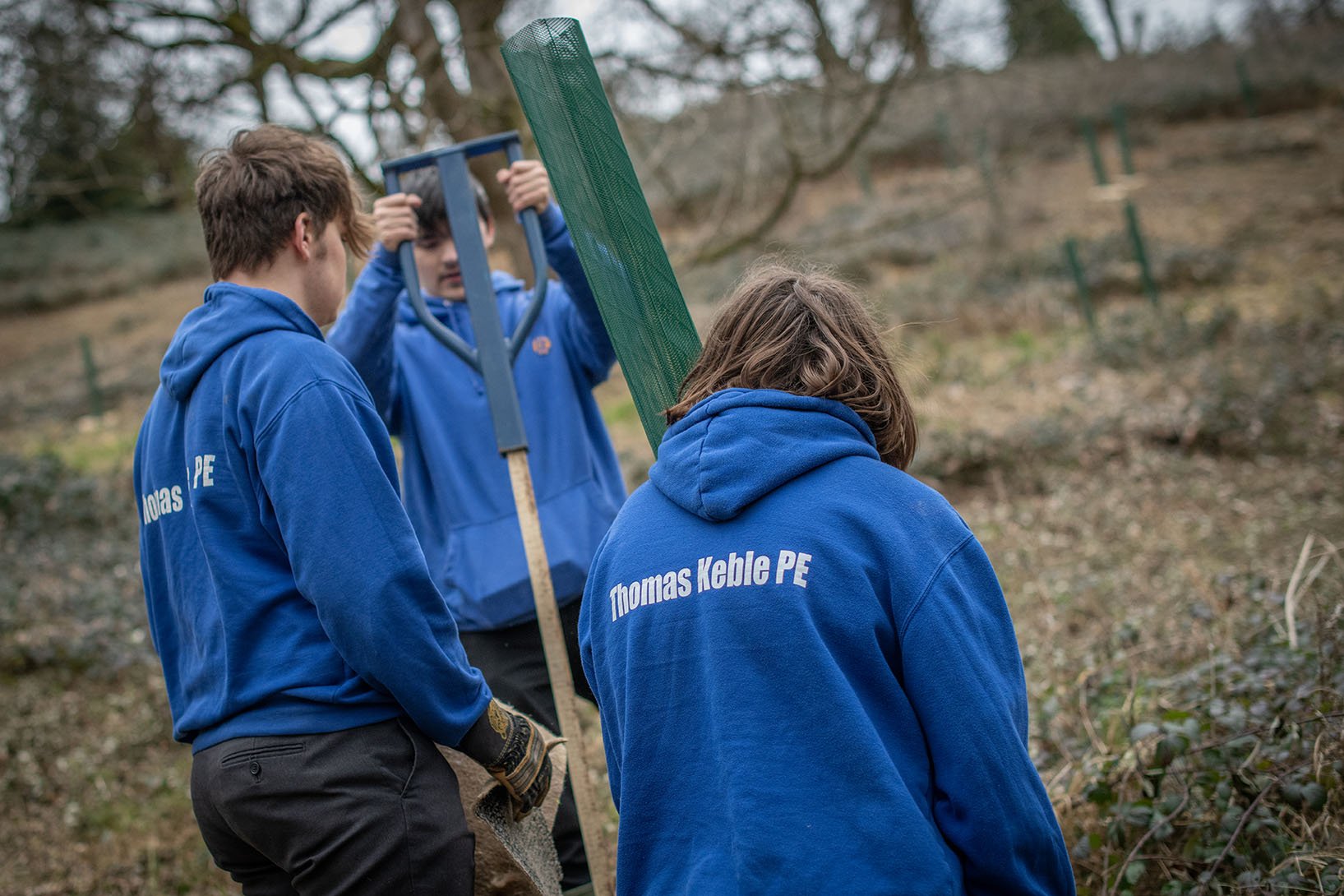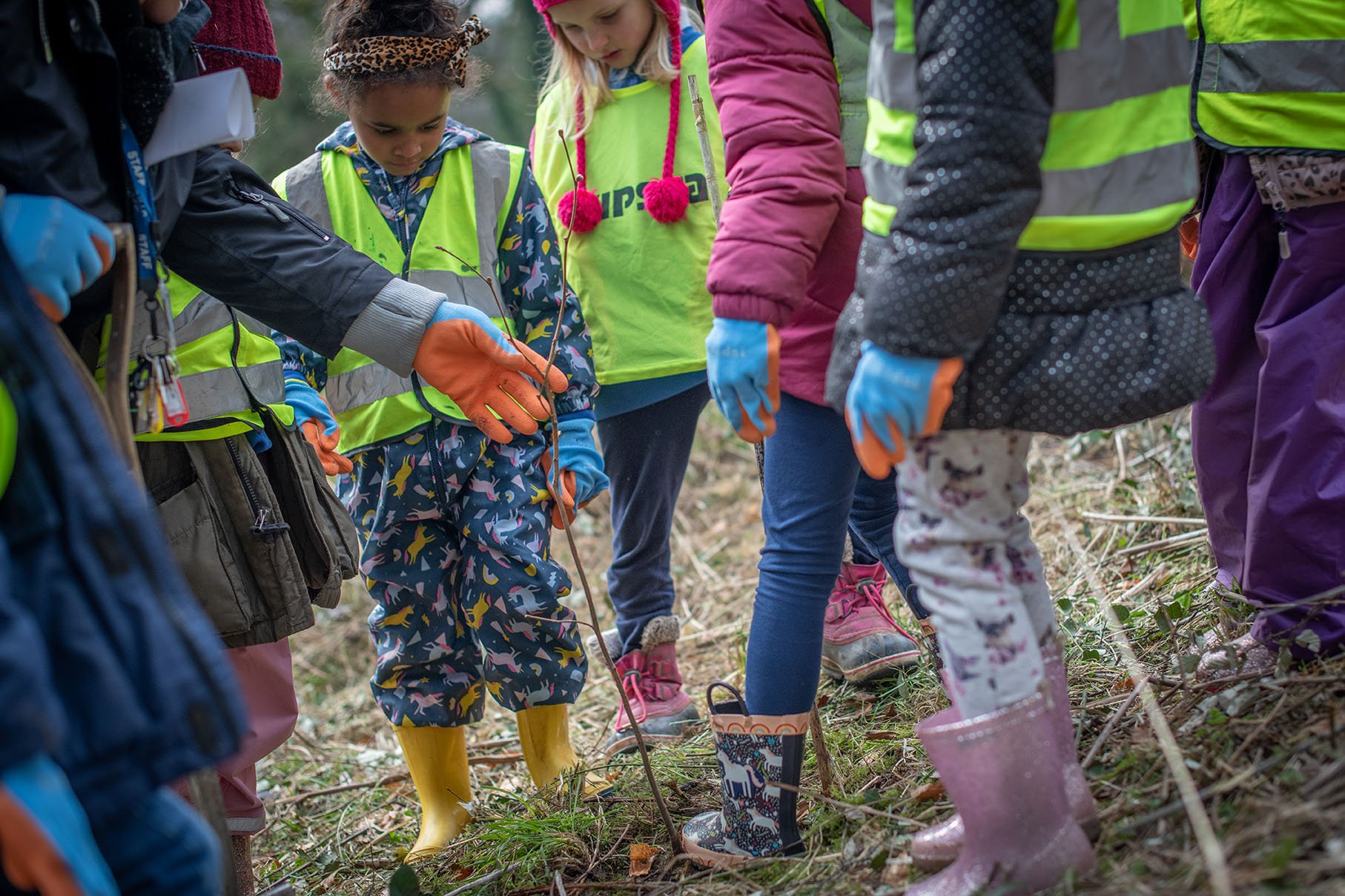Tree Planting
The last two years have taught us a great deal of things. Mostly, that we are not invincible and that our very comfortable way of life can unravel remarkably quickly. It would be fair to say we have all been left reeling from the effects of COVID-19, which has challenged our normal perceptions and uprooted our whole way of life.
Yet, while we clapped, cried and drank our way through the pandemic, it has been the trees, I think, that have shown the most patience. Not just any group of trees either, but specifically three hundred little saplings that we acquired from the Woodland Trust back in the Winter of 2020. Two years on and those little trees were still waiting to be rooted permanently into the ground. While the world was going crazy, those little guys waited.
For those of you not familiar with the Shared School Woodland Project, here’s a quick recap. Led by Oakridge School, the concept for the scheme came about by accident. The original intention for the trees was to use them to plant a hedge on Oakridge School’s allotment, however the local parish council refused. With three hundred saplings going spare we needed to come up with a Plan B. That’s when the idea came about to try and find a piece of land on which to plant a new woodland, and not just any woodland, a community woodland that could be shared by a number of different schools from the local area and used for outdoor learning to help encourage environmental education and teach a large number of children about the importance of caring for the natural world and the benefits of doing so.
It was at a tree conference at the Stroud Council Chambers where we got a lead that a landowner over in Chalford might be interested in helping. That’s when we met the wonderful Annie Kleiner. She had a parcel of land on Coppice Hill going spare. It was just scrub land, nestled between two portions of established woodland with streams criss crossing over, but it was perfect. Situated opposite Dimmel’s Dale, what is now a Gloucestershire Wildlife Trust nature reserve, the new woodland is going to help to reconnect existing woodland, filling gaps and creating a wildlife corridor that will play its part in local conservation.
An image of the site before planting shows a baron piece of scrub land
The newly planted saplings, protected in their tree guards, resemble an army of green soldiers
Much went into organising the tree planting event and persuading local schools to come on board. Working in conjunction with Thomas Keble, a popular secondary school near Stroud, the idea was to target the primary schools that feed into it in the hope that an army of environmental enthusiasts would be created and that enthusiasm developed further as the children moved onto Thomas Keble. Primary schools that signed up to the project included project leader Oakridge, plus Brimscombe, Rodborough, Thrupp, Minchinhampton, Bisley and Chalford Hill.
There was much excitement and momentum was really building. A family day was held to prepare the site for planting with lots of activities taking place including ground clearance, removing broken fencing and marking out where the trees would go. However, there was a menacing shadow lurking in the background and just a week before tree planting was meant to go ahead COVID struck and the whole country was plunged into lockdown. It was hugely disappointing. The project was put on hold indefinitely and the trees were temporarily planted and cared for by volunteers. As lockdown eased and normality was dangled in front of our noses we hoped to resume planting in November 2020, sadly though those plans were thwarted by another lockdown, which carried right through into January and beyond. While the pandemic raged, naturally, people’s priorities shifted and no one had time for trees.
Fast forward to Spring 2022 and the trees time has finally come - hurrah! Out of the original eight schools involved in the project, four were able to attend last week’s tree planting event - Oakridge, Rodborough, Chalford Hill and Thomas Keble. It was disappointing about the schools that couldn’t attend, but a lot has happened in two years and many are still on the back foot playing catch up. Some have new head teachers, while others are still suffering from staff shortages. Everyone is in a totally different place in their lives, it’s inevitable that focus shifts and priorities change but the fact we’ve stuck at it is down to the commitment and determination of all those involved. There is no denying it has been challenging to keep the momentum going with this project, but the fact that we have, made it all the more satisfying when we were finally able to welcome classes of school children to site last week.
It was really fantastic to see all the different children from all the different schools coming together to plant trees for the better good of themselves, their families and the wider community as a whole. Tuesday was our busiest day, with classes from both Rodborough and Chalford Hill attending. On Wednesday we welcomed Oakridge School and on Friday afternoon some year 11’s from the horticultural department at Thomas Keble came to help. We had a lovely variety of ages ranging from 5 through to 16 years old. Every different year group took something different away from the experience.
Rodborough School
Chalford Hill School
Oakridge School
Horticulture students from Thomas Keble School
On arrival, children were asked to make their way over to the rustic seating area where they were given a demonstration on how to plant the trees. They would first need to organise themselves into small groups and then collect all the items they would need - a spade, a mulch mat, a tree guard, five pegs, a stake and a tree. They then ran off to pick a cane, the marker for where they would plant their tree.
Once they had chosen a cane, their first task was to dig a hole. The children all took it in turns to have a go at this job, with the younger ones helping each other and the older ones just getting stuck in.
Next, the children gently placed the little sapling into the hole. Again, there was much enthusiasm to do this job but by taking it in turn and waiting patiently everyone was able to have a go.
The next task was to water the tree using a small bottle which the children filled up from the stream. The older ones helped the younger ones, and yes, there were a few soggy feet by the end of the morning!
Despite a few wet toes, the saplings appreciated the drink. It was lovely to see how gentle the children were with the trees, and how very obliging they were in wanting to help each other with all the different tasks.
Next the mulch mat was laid down around the base of the tree, done so to prevent competition from the very vigorous brambles.
Using rubber mallets, the children tapped in biodegradable pegs to secure the mulch mat to the ground.
The task that perhaps many of the children enjoyed the most was bashing the stake into the ground using the post basher! It’s a pretty weighty tool that few youngsters have ever had the opportunity to use. The slight element of danger added to its appeal. Even the bigger kids needed to lend their mates a hand…
…while the younger ones had help from adults…
…and when the post basher was busy being used by someone else, others just used their initiative and bashed the stake in using the back of a spade. A great lesson in trust, particularly if you’re the lad holding the stake.
It was heart warming to see parents working alongside each other to help the younger ones perform the jobs asked of them. Its what makes this whole community so special and encapsulates the very reason for creating this shared woodland in the first place.
Once the stake was firmly in and the mulch mat pegged down, the final job was to slip a tree guard over. The tree guards all came flat packed so the children enjoyed trying to reform the pliable mesh back into a cuboid, proving how outdoor learning can cover every subject in the National Curriculum.
Planting the trees gave a real sense of achievement. The fresh air and exercise stimulated happy brain cells, and the added incentive of planting the odd tree or two generated a really positive mindset in everyone. None of the children wanted to leave, but when they did, they were all buzzing.
The children were extremely proud of the trees they planted. There was stiff competition between some groups to see who could plant the most trees in a single hour, (six was the best one group managed) and some children even named the trees they planted. One girl wanted to plant a Rowan tree because her baby brother is called Rowan.
Year 1 pupils from Rodborough School
Another group of year 1 pupils also from Rodborough School
Providing children with the opportunity to get outside, get some fresh air and get their fingers dirty couldn’t have come at a better time when lots of these youngsters have been isolated from their usual friendship groups. For the very little ones, they will have spent half their lives in lockdown.
I’m not going to bang on about how children’s mental health has been affected over the last two years, but there were obvious issues being addressed by taking part in this activity that will go a long way in helping to ease some of the difficulties that many children may now be facing as a result of the pandemic, and more recently, the terrible tragedy unfolding in Ukraine. The news would have us believe there is no joy left in the world, but projects like this tell a different story.
Not all the trees made it into the ground, so they will be cared for over the Summer and planting will resume in the Winter, when we hope to invite those schools who wanted to come and plant but for whatever reason weren’t able to attend last week’s event.
This is only the beginning for the Shared School Woodland Project. It has been made clear to everyone involved and to all the families associated with the schools who have taken part that this is a space for them to use whenever they want to. Be it for school field trips, family picnics or to walk the dog. The shared woodland is for everyone to enjoy. May smiles and laughter bless the trees on their journey of growth and may the trees continue to support the children on their learning journey.
Our end goal has never wavered. Our objective has always been to get more kids outside caring about the natural world. To make sure they know that they have an important role to play in the fight against climate change and to ensure they understand the things they can do help. We want children to have more opportunities to be taught about environmental education and this woodland will help to make sure that happens.


























